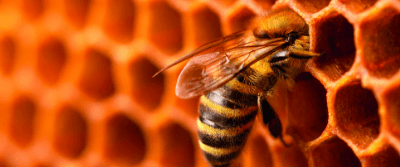Bees and Wasps Use Geometry to Construct Their Nests

By Mark Miller
Many honeybees and wasps face a construction challenge. To build their nests, bees use wax and wasps use paper pulp to form hexagons, which provide a stable, space- and material-efficient design. But as their homes expand, they need to make hexagons of different sizes, and the differing, six-sided shapes don’t connect efficiently. Recently, scientists discovered that the insects are using geometry to solve the problem.
Room to Grow
The kinds of bees and wasps that face this problem are social insects. This means that they cooperate in raising offspring that aren’t their own, live in populations where generations coexist, and limit reproduction to only certain members of their colonies, according to the article “Common Social Bees and Wasps of Pennsylvania: Behavior, Lifecycle, and Management,” published by Penn State Extension. During the growth of their nests, reproductive bees and wasps require spaces larger than those of existing worker cells—leading to a development dilemma.
“Think of someone tiling your bathroom floor,” said Michael L. Smith, PhD, a biologist at Auburn University, in the Science News Explores article “Bees and wasps devised the same clever math trick to build nests.” If you have to connect smaller hexagons with larger ones, there will eventually be “some kind of an issue when you try to [merge] them together.” For these insects, merging the different sizes could waste resources that they work hard to obtain. Bees must consume honey to produce wax and wasps need to gather pieces of wood and water to manufacture building materials.
Odd-Sided Solution
Smith and a team of researchers determined that geometry holds the architectural answer. The scientists used automated image technology to analyze 115 nests and measured the length of the cell walls and the number of neighboring cells. The analysis also included cells that were not perfect hexagons—something scientists had previously ignored but turned out to be the key to joining the different-sized cells.
The bees and wasps used five-sided pentagons and seven-sided heptagons to link the differing hexagons. When a pentagon is connected to a heptagon, the same number of outer sides results as when pairing two hexagons—ten.
Model Approach
Nils Napp, PhD, a computer scientist at Cornell University, used a mathematical model to demonstrate that simply adding larger hexagons to smaller ones would create wasteful gaps or the need to build unusable spaces. Based on the model, incorporating pentagons and heptagons would be an optimal response. “What the bees and wasps are doing is close to the best possible geometric solution,” he said in Science News Explores.

